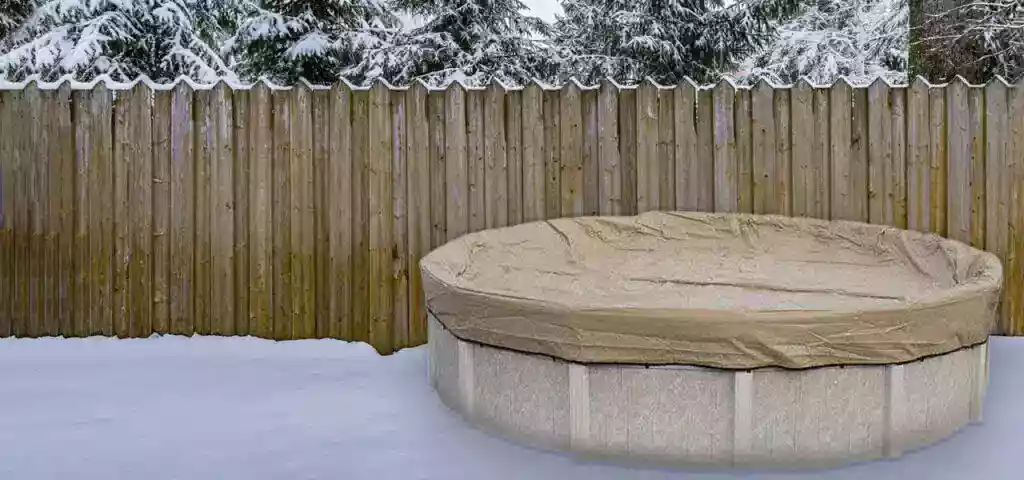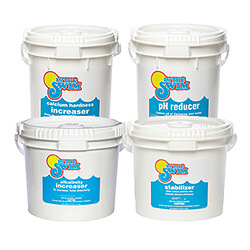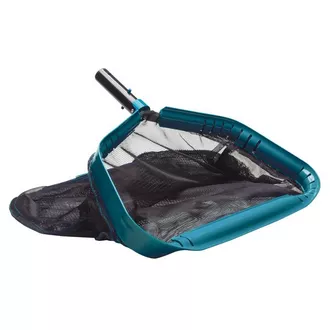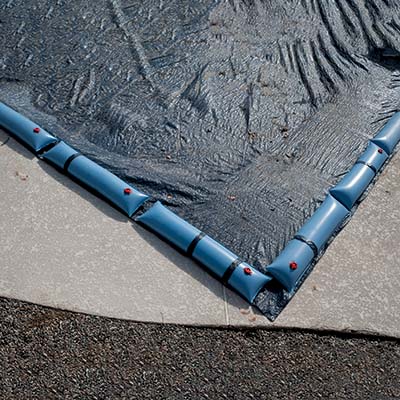FREE Standard Shipping On All Orders $100 or More!*

10 Steps to Winterize Your Above Ground Pool
As summer slowly draws to a close, now is the time to think about preparing your pool for winter. Prevent damage from snow and frozen water this winter, and make pool opening next spring a breeze! Learn how to expertly winterize your above ground pool with our 10 steps.

1. Balance Water Chemistry
The first step before you winterize your above ground pool is to balance the water chemistry about a week before you are ready to close. Test your pool water and ensure that the chemical levels are within the following ranges:
- pH: 7.4–7.6 ppm
- Total Alkalinity: 80–120 ppm
- Calcium Hardness: 200–400 ppm
- Chlorine: 2.0–4.0 ppm
2. Shock the Pool
After balancing the water chemistry, add diluted granular chlorine, or non-chlorine pool shock, to your pool water to remove any contaminants that could cause stains or algae during winter. The usual treatment is one bag (or pound) per 10,000 gals of pool water, for clear water. If your pool water is hazy or green, add double or triple the normal dosage. Use a brush afterwards, and brush the floor and walls until your arms wear out.

3. Clean the Pool
On the day of the pool closing, be ready to clean your pool with your pool vacuum, brush and skimmer net. Clean it well before lowering the water, and skim again before covering the pool, to remove any wind blown debris.
It's important to winterize your above ground pool when it's in spotless condition. Any debris left in the pool will use up your winterizing pool chemicals, affect water balance, and create ugly stains.
4. Remove Accessory Items
Remove your skimmer basket, return fittings, solar blankets, pool alarms, ladders or steps, and pool cleaners. Dry and stow them safely for the winter months - indoors or protected from the elements.
Solar blankets can be left on the solar reel, and covered with our durable winter solar cover. They can also be dried, folded and stored in a location inaccessible to mice.
5. Lower Water Level
Now, you can save the skimmer and save water with the aboveground pool Skimmer Plug. Just snap on the plastic skimmer cover, and you can keep the water at normal levels. Drain the skimmer pipe, or disconnect the hose connecting to the pump.
If you don't use a skimmer plug that fits into the opening to block water, you need to lower the water level below the mouth of your skimmer to prevent damage from frozen water. Lower the water level to about 3” below the skimmer opening. Removing too much water could stress your pool cover, liner or pool walls.
You can use your pool cover pump, or let the water run out of the return line hose by disconnecting it from the filter. If you have a low water suction line, in addition to the skimmer, close or plug the skimmer, and use the LWS line to lower the water below the skimmer, by setting the filter valve on waste or disconnecting the plumbing (next).
6. Drain & Plug the Pipes
For the return line, back to the pool: If you have filter hoses, use a winter pool plug, or the threaded 1.5" plug with o-ring on the return line - on the inside of the pool, and then disconnect the hose, draining it dry. If you have hard PVC pipes that cannot be removed, use a large wet/dry vac to blow (or suck) the water from the pipes, and add pool antifreeze for extra protection.

For the skimmer, remove and drain the hose connected to the pump. If you have hard PVC pipes, drain, suck or blow water out. Use a winter skimmer plug to keep water out of the pipe during winter. PVC pool pipe cracks easily when the temperature falls below 32 degrees, so be sure all the water is out, or add antifreeze if you're not sure.
The Skimmer Guard Gizmo is a combination skimmer plug and skimmer protector. It plugs the pipe to keep water out, but also absorbs ice expansion inside the skimmer. Skimmers can fill up during the winter, expand, and easily crack a skimmer housing. The Skimmer Guard Gizmo absorbs the expansion, protecting the sidewalls of your skimmer. It includes a #9 rubber expansion plug to seal up the return line.
7. Drain the Equipment
The next step to winterize your above ground pool is to drain all the pumping, filtering, heating and chlorinating equipment and blow out all water from plumbing lines. Otherwise, the water will freeze and crack the equipment. After draining, pool pipes should be sealed at the pool with plugs, to keep water out of the pipes and equipment during winter.
Pumps have 1 or 2 drain plugs.
Filters have 1 cap or plug near the bottom.
Gas heaters have drain plugs on each side.
Solar pool heaters have a union or drain cap, or blow air through the solar panels.
Heat pumps loosen union nuts, slide back and tip the unit slightly to drain.
Chlorinators or Purifiers have 1 drain plug.

Be sure to shut off the power and gas supply to gas-fired pool heaters. You can protect pool heaters and heat pumps with a pool heater cover to prevent damage caused by snow, dirt, debris, and animals. Mothballs or mint sachets are also effective at keeping nesting mice out of pool heaters.
For DE pool filters and filter cartridges, a final cleaning and inspection is needed while closing the pool. Remove your filter grids or filter cartridge and hose thoroughly. Soak in our filter cleaner to have grids or cartridges at their cleanest, before replacing them into the filter for dry winter storage. Sand filters also benefit from an end of year cleaning to remove oils and mineral scale.
Finally, at the equipment pad, be sure to shut off all power to the pump, lights, heater and other equipment. If you can easily remove the entire equipment pack for indoor storage, that would be best.
8. Lubricate O-rings
Now is also a good time to lubricate the soft rubber o-rings or threaded metal parts of your equipment. Use a Teflon based pool lube for rubber o-rings on your pump lid o-ring, filter tank o-rings, union o-rings, drain plug o-rings, or any other rubber o-ring on your pool equipment.
9. Add Winter Closing Chemicals
In addition to maintaining good water balance during the winter, adding winter algaecides and chemical floaters keeps your pool water clean and clear during winter. Not adding the right chemicals when you winterize your above ground pool will lead to a long and costly spring clean-up.
A pool winterizing kit makes the process more convenient - just buy the winter kit that matches your pool size. In The Swim winter kits include algaecide, non-chlorine shock, stain & scale preventative, slow release floater and oil absorbing sponge.
10. Cover Your Pool

Last but not the least; cover your pool with a tight fitting pool cover to ensure that debris and leaves cannot get into your pool. Winter pool covers for above ground pools come in a variety of round and oval sizes, order by pool size for a perfect fit.
Air pillows are used in to break up the ice sheet that forms in the pool under the cover, during several days of below freezing weather. This prevents damage to the pool walls and skimmer from a solid sheet of ice expanding outward.
If there are large trees surrounding your pool, put a leaf catcher on top of your winter cover. Lightweight and super tough mesh lets you remove all leaves and debris in one easy motion.
One more winter pool cover accessory is worth mentioning. You'll need some way to remove the rain water and snow melt from the cover, either with an electrical or gravity fed pool cover pump.